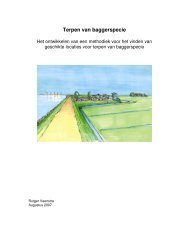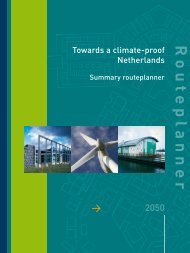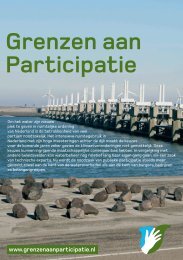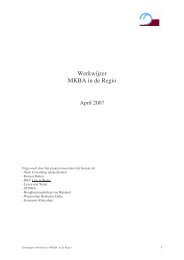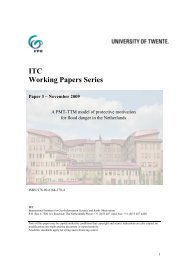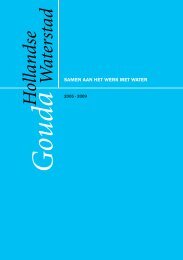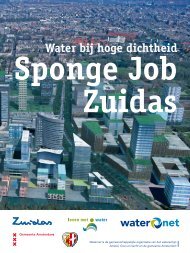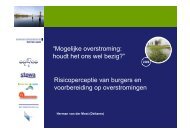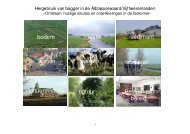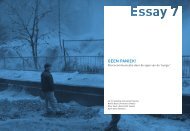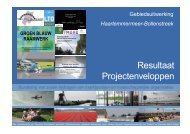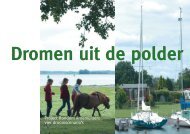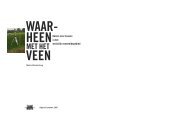Deltas on the move; Making deltas cope with the effects of climate c
Deltas on the move; Making deltas cope with the effects of climate c
Deltas on the move; Making deltas cope with the effects of climate c
- No tags were found...
Create successful ePaper yourself
Turn your PDF publications into a flip-book with our unique Google optimized e-Paper software.
KvR report 001/2006<str<strong>on</strong>g>Deltas</str<strong>on</strong>g> <strong>on</strong> <strong>the</strong> <strong>move</strong>Figure 5.2:Sample output generated by DIVA and exported as bitmap.Physical vulnerabilityThe first type <strong>of</strong> indicator, physical vulnerability, would include a risk assessmentcombining geophysical probability <strong>with</strong> <strong>effects</strong> <strong>on</strong> coastal ecosystems. Thus, physicalvulnerability is interpreted here as vulnerability <strong>of</strong> coastal land and ecosystems t<strong>of</strong>looding by <strong>the</strong> sea and by rivers including <strong>effects</strong> <strong>of</strong> any associated sediment loadsand depositi<strong>on</strong>. Geophysical probability would include storm surges, net sea levelrise, possibly tsunami’s and <strong>the</strong>ir c<strong>on</strong>sequent flooding.<str<strong>on</strong>g>Deltas</str<strong>on</strong>g> in DIVADIVA c<strong>on</strong>tains a separate set <strong>of</strong> 115 major world rivers, it does not identify whe<strong>the</strong>r<strong>the</strong>se rivers have a delta at <strong>the</strong>ir mouth. Each river is matched to a coastal segment.It c<strong>on</strong>tains mean depth, slope and discharge at <strong>the</strong> river mouth obtained from varioussources. Since <strong>the</strong> river data are linked to coastal segments, it is possible to addressqueries <strong>on</strong> coastal vulnerability (comprising both <strong>the</strong> physical and socio-ec<strong>on</strong>omicaspects) and s<strong>of</strong>t engineering potential <strong>with</strong> a manual pre- and post-processing step.The pre-processing is explained above. Post-processing in <strong>the</strong> present pilot studyinvolved a screening <strong>of</strong> potentially useful output variables and <strong>the</strong> development andtesting <strong>of</strong> a set <strong>of</strong> indicators. Indicator development is carried out below in secti<strong>on</strong>5.5, whereas WDD and DIVA output screening, matching and preliminary indicatortesting is d<strong>on</strong>e in secti<strong>on</strong> 5.6.5.5 Developing three types <strong>of</strong> possible indicatorsHaving access to <strong>the</strong>se rich data collecti<strong>on</strong>s, <strong>the</strong> challenge is now to extract <strong>the</strong>variables from <strong>the</strong>se databases that can be matched to <strong>the</strong> three major types <strong>of</strong>indicators covering different aspects <strong>of</strong> <strong>the</strong> coast at a cross secti<strong>on</strong> <strong>with</strong> a riverinedelta. As previously announced in secti<strong>on</strong> 5.1., <strong>the</strong>se are:1. <strong>the</strong> physical vulnerability <strong>of</strong> <strong>the</strong> coast;2. <strong>the</strong> stock at risk for <strong>the</strong> human society;3. <strong>the</strong> potential <strong>of</strong> s<strong>of</strong>t, ecosystem-oriented engineering soluti<strong>on</strong>s to allow adaptati<strong>on</strong>or mitigati<strong>on</strong> resp<strong>on</strong>ses <strong>of</strong> coastal society <strong>with</strong> c<strong>on</strong>siderati<strong>on</strong> <strong>of</strong> natural,ecosystem processes.The DIVA tool does <strong>of</strong>fer a range <strong>of</strong> indicators that can be extracted and reflect asubstantial proporti<strong>on</strong> <strong>of</strong> <strong>the</strong> informati<strong>on</strong> needed for a first assessment <strong>of</strong> deltaicvulnerability and potential for s<strong>of</strong>t engineering measures. The WDD in turn, c<strong>on</strong>tainsgeomorphological indicators including a number that describe <strong>the</strong> catchment. Thus,<strong>the</strong>se indicators could serve for physical vulnerability and physical potential for s<strong>of</strong>tengineering.48A range <strong>of</strong> processes is included in coastal engineering estimates <strong>of</strong> dike failure,<strong>of</strong>ten derived from incidence statistics to date and reported as a 1 in 10, 100 or 1000year probability. The DIVA tool calculates a compound indicator <strong>of</strong> vulnerability foreach coastal segment, labeled <strong>the</strong> Current Segment Vulnerability Score (CSVS). Itreflects <strong>the</strong> combined forcing resulting from four envir<strong>on</strong>mental forcing factors:sediment supply, accommodati<strong>on</strong> space, relative sea level rise and tidal range. ThisCSVS does not include <strong>the</strong> <strong>effects</strong> in society, it is <strong>on</strong>ly an indicator <strong>of</strong> <strong>the</strong> probability<strong>of</strong> coastal land loss. However, for <strong>the</strong> sake <strong>of</strong> transparency, <strong>the</strong> present study hasopted to mainly focus <strong>on</strong> <strong>the</strong> simpler, c<strong>on</strong>stituent comp<strong>on</strong>ents <strong>of</strong> <strong>the</strong> CSVS. TheWDD <strong>of</strong>fers an estimate <strong>of</strong> delta area, a proporti<strong>on</strong> <strong>of</strong> it that is subaqueous, <strong>the</strong><strong>of</strong>fshore slope, height <strong>of</strong> spring tide and wave power as interesting indicators.Socio-ec<strong>on</strong>omic riskIn <strong>the</strong> sec<strong>on</strong>d type <strong>of</strong> indicator, <strong>the</strong> c<strong>on</strong>sequent risk <strong>of</strong> coastal human society wouldbe covered. This would entail human lives and ec<strong>on</strong>omic loss, but also humaninfrastructure as well as o<strong>the</strong>r valuable items, such as world heritage sites. Forexample, DIVA does also estimate <strong>the</strong> number <strong>of</strong> people at risk (PAR) <strong>of</strong> flooding asaverage number <strong>of</strong> people flooded per year by storm surge allowing for <strong>the</strong> effect <strong>of</strong>flood defense for each administrative unit and per time slice and scenario applied. Arange <strong>of</strong> cost estimates are <strong>on</strong>ly estimated <strong>on</strong> a per-country-basis, <strong>the</strong>se areaggregated up into a total cost <strong>of</strong> adaptati<strong>on</strong>. Therefore <strong>the</strong>se DIVA-indicators areless suitable in <strong>the</strong> present project.S<strong>of</strong>t, ecosystem-based engineeringThe potentials for s<strong>of</strong>t, ecosystem-based engineering are <strong>the</strong> third type <strong>of</strong> indicator.These would depend <strong>on</strong> (a) overall gross sediment availability in a sediment budget(t<strong>on</strong>s km -2 y -1 ) including terrestrial and marine sources, (b) local coastal topography(sea bed and coastal plain), i.e. availability <strong>of</strong> space for a natural coastaldevelopment. Strength <strong>of</strong> <strong>the</strong> local hydrodynamics (currents, tide and wave <strong>climate</strong>)may well modulate sediment availability. As an example, DIVA estimates an indicator<strong>of</strong> sediment supply (SEDSUP) as input for each coastal segment. This compoundindicator includes tect<strong>on</strong>ics, river supply, adjacency <strong>of</strong> sea ice, localgeomorphological setting, history <strong>of</strong> land use and present coastal management(presence <strong>of</strong> dikes). SEDSUP is reported in 5 categories, from high supply coupledto low vulnerability to low supply. The WDD <strong>of</strong>fers data to estimate <strong>the</strong> potentialspace available and local hydrodynamics.Traditi<strong>on</strong>al s<strong>of</strong>t-engineering measures are beach nourishment, reservati<strong>on</strong> <strong>of</strong> floodc<strong>on</strong>tainingplains, and managed, local retreat. Clearly, <strong>the</strong> potential success <strong>of</strong> <strong>the</strong>sewill depend <strong>on</strong> <strong>the</strong> above listed availability <strong>of</strong> sediment and accommodati<strong>on</strong> space in<strong>the</strong> coastal z<strong>on</strong>e. Local adaptati<strong>on</strong> (e.g. refuge hills), or mitigati<strong>on</strong> (financialcompensati<strong>on</strong>) measures would have different bases <strong>of</strong> success. Their potential49



